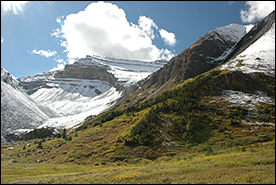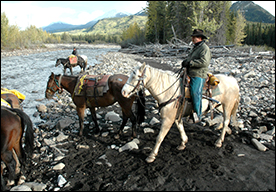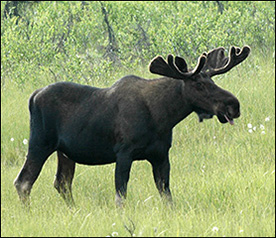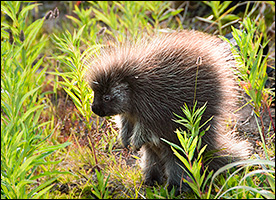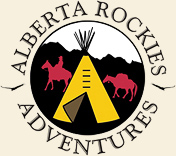Willmore Wilderness Park
Willmore Wilderness Park located in the Canadian Rockies, is a pristine mountainous area with rugged forest and alpine expanses. The rivers and streams are crystal clear. Fast moving streams are a good source of drinkable water. The park is a paradise for outdoor enthusiasts; but it should be noted that travelers in the remote areas should have extensive outdoor experience or hire an outfitter/guide for their expedition. The only modes of transportation allowed in Willmore are by foot, horse, mountain bike or ski. Motorized activities are not permitted due to the designation of this wilderness reserve.
Willmore Wilderness Park is 4,600 square kilometers (1840 sq. mi.) and lies in the Alberta Rockies directly north of Jasper National Park. Willmore has fewer visitors than Jasper. Adventurers can view a variety of wildflowers and wildlife. Travelers often see mountain goats, bighorn sheep, elk, deer, moose, caribou, wolves, coyotes, wolverine, cougar, lynx, black bears and small game. Flowers are abundant in the summer months and turn meadows into a tapestry of colour. Fossil evidence contributes to the ancient history of the area – some of the most superlative fossil remains are dinosaur tracks located just north of Grande Cache.
Willmore Wilderness Park Staging Areas
Willmore Wilderness Park has four major horse staging areas making access to the Alberta Rockies available. These areas include the Sulphur Gates, Cowlick Creek, Berland River and Rock Lake. Corrals are present for those who venture into the park on horseback.
The Park
Ambitious hikers or horseback riders can view spectacular alpine and sub-alpine lakes. The largest lake in the park is Ptarmigan Lake. Only experienced outdoor adventurers should visit this rugged region of the Park. Serious outdoor enthusiasts can also travel to the Continental Divide. The Divide gives birth to many streams and rivers that supply water to the Peace and Athabasca River systems. Some of these rocky mountain rivers and streams are the Sheep, Jackpine, Smoky, Berland, Sulphur, Muskeg and Wildhay. Rocky Mountain whitefish, rainbow trout and bull trout are common in many of Willmore Wilderness Park’s streams. The heavily timbered trails are often difficult to traverse. Deadfall covers many of the original paths, and work is needed to restore the travel-ways to their original condition. This is one of the Foundation’s goals.
Willmore Wilderness Park Trails
The Willmore Wilderness Park is a horseman and hiker’s dream. Trips through Eagle’s Nest Pass, Jackknife Pass, Rocky Pass or the most westward passes on the Continental Divide are breathtaking and beautiful. Willmore Wilderness Park Trails along the Divide meander through Forget-Me-Not, Fetherstonhaugh, and Morkill Passes. Horseback trips follow the old trails used by the outfitters of the past. Backpacking and mountain biking are great ways to get exercise and experience the scenery for those who do not use a horse. If photography is a passion, the mountain vistas, abundance of wildlife and the variety of alpine flowers will quickly fill rolls of film. Although Willmore is a park, both hunting and fishing are allowed. Local commercial Trail Riding Outfitters are able to enhance these activities.


